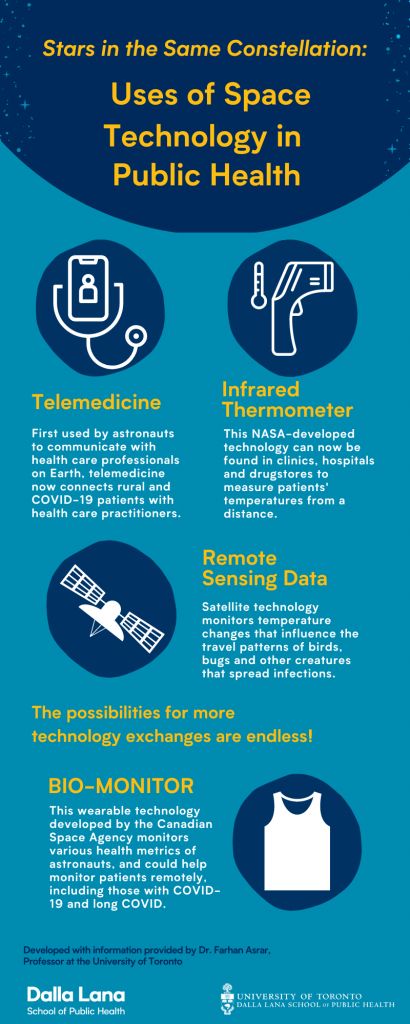Stars in the same constellation: DLSPH researcher on the mutual benefits of space and health innovations
January 12/2023
By Bonnie O’Sullivan
Photo: Prof. Farhan Asrar (right) with Dr. David Saint-Jacques (Canadian astronaut, family doctor, and co-author). Taken at the Canadian Space Agency Head Quarters.
“I’m a doctor, not an engineer,” said Star Trek’s Dr. Leonard McCoy when asked to do something outside his comfort zone. His story may exist in a fictional future, but space and health care technology have shared a real symbiotic relationship for decades.
The United Nations Conference on the Exploration and Peaceful Uses of Outer Space committed to using space technology to help control infectious diseases in 1999, thus officially recognizing and pledging an exchange of knowledge between space engineers and those in health care fields.

However, Professor Farhan Asrar, lead author of the recent paper, Outer space assets offer benefits to health care, points out that health care has been an integral part of every human space mission since the 1960s. Asrar is a family doctor, professor of Clinical Public Heath at the Dalla Lana School of Public Health, an assistant professor at the Department of Family and Community Medicine and is based with Trillium Health Partners. As a global faculty member for the International Space University, Asrar co-organizes and speaks at conferences about the connections between space and health care. “For any human mission that has taken place, those involved have to ensure that they can adequately take care of the humans that are going to space,” he says. “The astronaut’s health must be monitored, maintained and assisted during their mission. I don’t believe a human-space mission can be given a go-ahead if we cannot reassure that the astronaut’s health will be adequately taken care of.”
With this requisite for health care in space comes unique challenges that we don’t face on Earth. This requirement – and the innovations that come from it – results in a cyclical exchange in which current Earth technologies are used and improved upon for space travel, and vice versa.
Asrar says that early examples of telemedicine come from astronauts communicating with health care professionals back home. Years of space developments in telemedicine informed remote care during the COVID-19 pandemic. Now, scientists are looking for even more effective ways to provide medical information to space explorers. For instance, if there was a health emergency on Mars, it would take at least 20 minutes or more for the communication to reach earth. This is where developments in machine learning and artificial intelligence are being used to improve the astronauts’ access to quicker answers, explains Asrar, who is a member of the Temerty Centre for AI Research and Education in Medicine.
In a 2021 Nature Medicine article, Asrar and his co-authors describe the uses of the BIO-MONITOR, developed for the Canadian Space Agency, to store and forward health data from body-worn sensors. “This wearable technology offers around-the-clock monitoring of heart rate, breathing, blood pressure, temperature, electrocardiogram, physical activity and blood oxygen levels, which are valuable parameters to monitor in patients with active COVID-19 or long COVID,” write the authors. Another device that we are all familiar with, especially during the pandemic, is the infrared thermometer. This NASA-developed technology can now be found in clinics, hospitals and drugstores.
Remote sensing data is one more example of space technology being used to improve public health on Earth. Satellite technology monitors temperature changes that influence the travel patterns of birds, bugs and other creatures that spread infections. “You can actually monitor and plan out the migratory patterns, which could potentially let us know that there is a high influx of certain vectors in certain regions,” says Asrar.
These technologies are just some of the many examples in which space and health innovations can be exchanged. And there will be more to come. Asrar encourages professionals to seek development and collaboration outside of their vocations when faced with a new challenge. “Whether you’re a surgeon or a public health professional, whether you focus on the macro level, emergency preparedness, or individual health care, there is space technology that could assist you,” says Asrar.